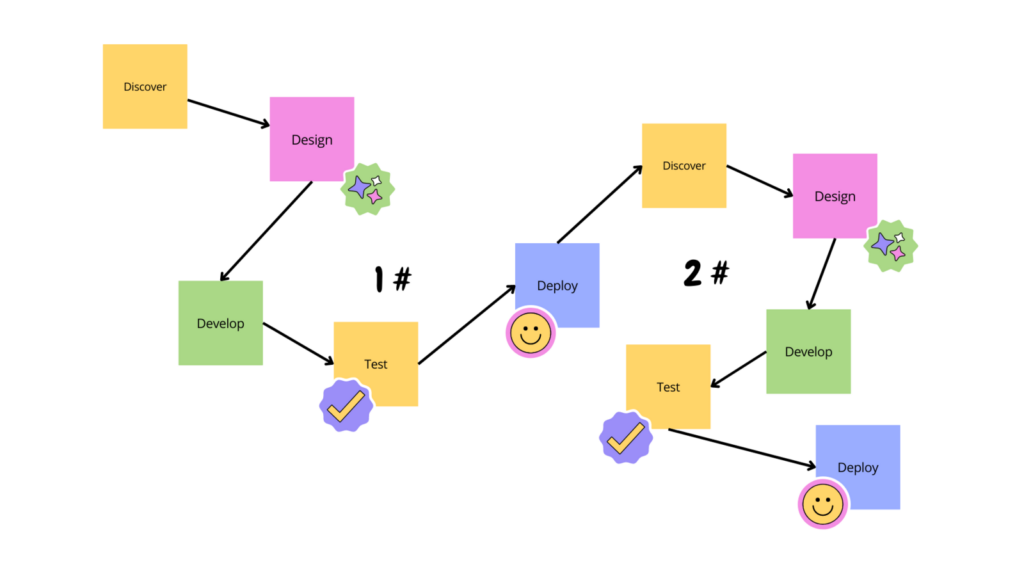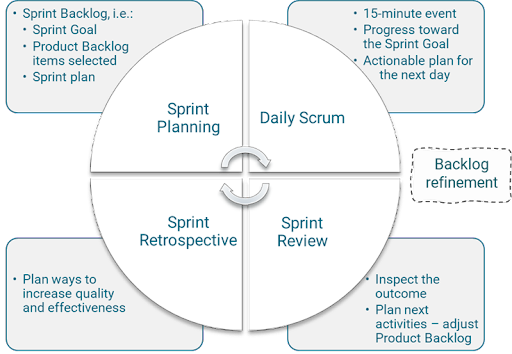Agile and Scrum are two of the most widely used frameworks in the world of project management and software development. Both Agile vs Scrum emphasize improving flexibility, collaboration, and customer satisfaction, but they differ significantly in their structure, principles, and implementation. Understanding these differences is crucial for selecting the right framework for your team or organization. Let’s explore these differences in detail, along with the pros and cons of each framework.
What is Agile?

Agile project management philosophy focuses on flexibility, collaboration, and customer satisfaction through iterative and incremental development. It is rooted in a set of guiding principles and values designed to help teams respond to changes quickly, especially in software development. Agile prioritizes adaptive planning, early delivery, and continuous improvement, emphasizing the importance of communication and collaboration between all stakeholders.
The Agile Manifesto, created in 2001 by a group of software developers, sets out the core values of Agile project management. These values include:
- Individuals and Interactions over Processes and Tools: Agile teams prioritize communication and collaboration among team members over rigid processes or tools. This ensures flexibility in how tasks are approached and promotes teamwork.
- Working Software over Comprehensive Documentation: Rather than focusing heavily on detailed documentation, Agile emphasizes delivering working software or products that meet the client’s needs. Documentation is kept just enough to ensure the project’s success.
- Customer Collaboration over Contract Negotiation: Agile stresses the importance of ongoing collaboration with the customer throughout the project. Instead of sticking rigidly to predefined contracts, Agile teams work closely with customers to understand their evolving needs and adjust the product accordingly.
- Responding to Change over Following a Plan: Agile embraces change, recognizing that customer requirements and market conditions can evolve. Agile teams are adaptive, ready to change direction based on feedback or new insights, rather than strictly following a set plan.
These values are backed by 12 principles that guide Agile teams in their work. Some of these principles include delivering software frequently, maintaining a sustainable pace of work, and welcoming changing requirements, even late in development.
What is Scrum?

Scrum is an Agile framework used to structure and manage work in iterative, time-boxed cycles known as sprints. It helps teams deliver incremental value at the end of each sprint, typically lasting 2 to 4 weeks. The goal of Scrum is to ensure that teams remain focused, collaborate effectively, and continuously improve their processes while delivering high-quality products that meet customer needs.
Scrum goes beyond the foundational Agile principles and introduces a specific set of roles, events, and artifacts that guide teams in their work. It provides a more structured approach to applying Agile, making it easier for teams to implement and sustain Agile practices over time. While it is flexible and adaptable, Scrum defines clear guidelines to create a predictable and efficient workflow.
Key Components of Scrum
Roles in Scrum
Scrum defines three core roles, each responsible for specific functions in the project:
- Product Owner: The Product Owner is responsible for defining the product backlog (a list of features, requirements, or tasks that need to be completed) and ensuring that the team delivers value by prioritizing the most important work. They act as the primary point of contact for stakeholders and users, ensuring that the team works on the right things.
- Scrum Master: The Scrum Master acts as a facilitator and coach for the Scrum team. They help remove any obstacles that may impede the team’s progress, ensuring that the Scrum process is followed and that team members have everything they need to succeed. The Scrum Master helps the team work efficiently and continuously improve their processes.
- Development Team: The Development Team is a group of professionals who work together to complete the tasks in each sprint. They are self-organizing, meaning they have the authority to determine how best to complete the work. They are cross-functional, meaning the team members have a variety of skills that allow them to handle different aspects of product development.
Scrum Artifacts
Scrum uses three primary artifacts to guide the development process:
- Product Backlog: A dynamic, ordered list of all the work needed to be done on the project, maintained by the Product Owner. It includes features, improvements, bug fixes, technical work, or knowledge acquisition necessary to fulfill the project vision.
- Sprint Backlog: A subset of the Product Backlog that the team commits to complete during a sprint. It includes the items from the Product Backlog selected for the sprint and a plan for delivering the work.
- Increment: The Increment is the completed work at the end of each sprint. It must be a usable, working product that meets the team’s definition of “done.” It is the sum of all the Product Backlog items completed during the sprint and all previous sprints.
Scrum Events
Scrum incorporates several key events that allow teams to plan, collaborate, inspect, and adapt their work. These events include:
- Sprint: The core event in Scrum, a Sprint is a time-boxed cycle (usually 2-4 weeks) in which the team works on a set of tasks from the Product Backlog. At the end of each Sprint, the team delivers a potentially shippable product increment.
- Sprint Planning: This event happens at the beginning of each Sprint and is used to plan what will be accomplished during the Sprint. The team selects the Product Backlog items that will be worked on and defines the Sprint Goal. It is a collaborative meeting involving the Product Owner, Scrum Master, and Development Team.
- Daily Scrum: Also called the Daily Standup, this is a 15-minute meeting where the Development Team synchronizes their work and discusses progress. Each member answers three key questions: What did I do yesterday? What will I do today? Are there any blockers or obstacles?
- Sprint Review: At the end of each Sprint, the team holds a Sprint Review meeting to demonstrate the Increment and gather feedback from stakeholders. The Product Owner may update the Product Backlog based on feedback received.
- Sprint Retrospective: After the Sprint Review, the team holds a Sprint Retrospective meeting. This is an opportunity for the Scrum Team to reflect on the Sprint process, discuss what went well, what could be improved, and make plans to implement improvements in the next Sprint
Agile vs Scrum: Understanding the Key Differences
Agile and Scrum differ fundamentally in their approach: Scrum is a methodology used by software development teams, while Agile is a broader philosophy guiding how software is delivered to customers. Scrum focuses on delivering business value quickly through sprints, whereas Agile emphasizes continuous iteration with regular feedback.
In Agile, software is delivered regularly for feedback, while Scrum delivers after each sprint. Both methods share collaborative iterations, but Scrum is more rigid and ideal for quick results, while Agile is better for smaller teams seeking a straightforward approach. Scrum is often used for creative and experimental projects, while Agile offers more flexibility.
Here’s the comparison between Agile and Scrum in a table format:
| Aspect | Agile | Scrum |
| Definition | A broad project management philosophy or framework. | A specific Agile methodology focused on iterative work. |
| Focus | Emphasizes flexibility, collaboration, and continuous improvement. | Focuses on organizing work into short, manageable sprints. |
| Scope | Broad approach; can be applied through various methodologies (Kanban, XP, etc.). | A structured methodology that provides specific roles, events, and artifacts. |
| Principles and Values | Guided by core principles and values (from Agile Manifesto). | Follows specific principles within the Scrum framework. |
| Methodologies | Can be implemented using various methodologies. | Scrum is one of the methodologies that implement Agile. |
| Roles | No defined roles outside of the core principles of Agile. | Defined roles such as Product Owner, Scrum Master, and Development Team. |
| Structure | Flexible and adaptable to the project’s needs. | Structured with defined processes like Sprint Planning, Daily Scrum, and Sprint Retrospective. |
| Processes | Iterative approach, with the flexibility to adjust over time. | Uses time-boxed sprints to deliver work incrementally. |
| Client Interaction | Requires regular client interaction and feedback. | Frequent interaction through Sprint Reviews and Daily Scrums. |
| Implementation | Can be implemented in multiple ways (Kanban, XP, Scrum). | Scrum is the specific methodology within Agile for structured work. |
| Flexibility | Highly flexible and can be adapted to any project type. | Less flexible in terms of process, but offers clear guidelines. |
Pros & Cons Explained
Both Agile and Scrum are popular project management approaches, each with its own set of benefits and challenges. While Agile provides flexibility and adaptability in response to change, Scrum offers a structured methodology for teams to work within. Below, we break down the pros and cons of each approach:
Agile:
Pros:
- Flexibility & Adaptability: Agile allows teams to easily adjust to changes in project requirements or scope.
- Improved Customer Satisfaction: Frequent feedback and iteration ensure the product meets the customer’s needs.
- Faster Time to Market: Agile’s iterative process enables quicker delivery of working software or features.
- Better Collaboration: Regular communication between the team and stakeholders promotes alignment and transparency.
- Continuous Improvement: Teams can refine their processes and products during each iteration.
Cons:
- Requires High Customer Involvement: The iterative process demands ongoing feedback and active participation from the client.
- Scope Creep: The flexibility of Agile can lead to scope creep if not carefully managed.
- Requires Skilled Teams: Success depends on the skills and discipline of the development team.
- Documentation Can Suffer: Agile’s focus on working software may lead to minimal documentation.
- Difficulty Scaling: Scaling Agile for larger teams or complex projects can be challenging.
Scrum:
Pros:
- Clear Roles & Responsibilities: Defined roles (e.g., Scrum Master, Product Owner) promote accountability and clarity.
- Frequent Deliverables: Regular sprints ensure that progress is consistently made and results are delivered.
- Improved Transparency: Daily standups and sprint reviews keep everyone informed and focused on goals.
- Increased Focus: Short, time-boxed sprints help teams remain focused on specific deliverables.
- Continuous Improvement: Sprint Retrospectives allow teams to review and improve their processes regularly.
Cons:
- Rigidity: Scrum’s defined structure may feel restrictive, especially when flexibility is required.
- Resource Intensive: Scrum requires dedicated roles, making it more resource-intensive than other methodologies.
- Requires Team Discipline: Teams must be highly disciplined to follow Scrum processes effectively.
- Overemphasis on Meetings: The frequent meetings in Scrum can be time-consuming and may feel excessive.
- Steep Learning Curve: Teams unfamiliar with Scrum may face difficulties in understanding and implementing the framework.
Which is Better: Agile or Scrum?
Choosing between Agile and Scrum depends on the specific needs of your team and project. Both have their strengths and weaknesses, and the “best” option varies based on your objectives, team size, and project type.
When to Choose Agile:
- Flexibility is Crucial: If you need a flexible framework that can quickly adapt to changing requirements or market conditions, Agile might be the best choice.
- Small Teams: Agile is often more suitable for smaller teams or projects with less complex needs where a more straightforward, iterative approach can be adopted.
- Continuous Collaboration: If you require constant customer involvement and feedback to shape the final product, Agile provides this ongoing interaction.
When to Choose Scrum:
- Clear Structure and Roles: If your team benefits from defined roles and processes, Scrum provides a structured framework with clear responsibilities, timelines, and deliverables.
- Time-sensitive Projects: Scrum’s sprint-based approach is ideal for projects that require rapid, incremental delivery of product features.
- Larger Teams or Complex Projects: Scrum’s structure works well for larger teams or more complex projects that need a more disciplined approach to managing multiple tasks simultaneously.
- Continuous Improvement Focus: If your team is committed to regular reflection and process improvements (via Sprint Retrospectives), Scrum fosters this mindset.
